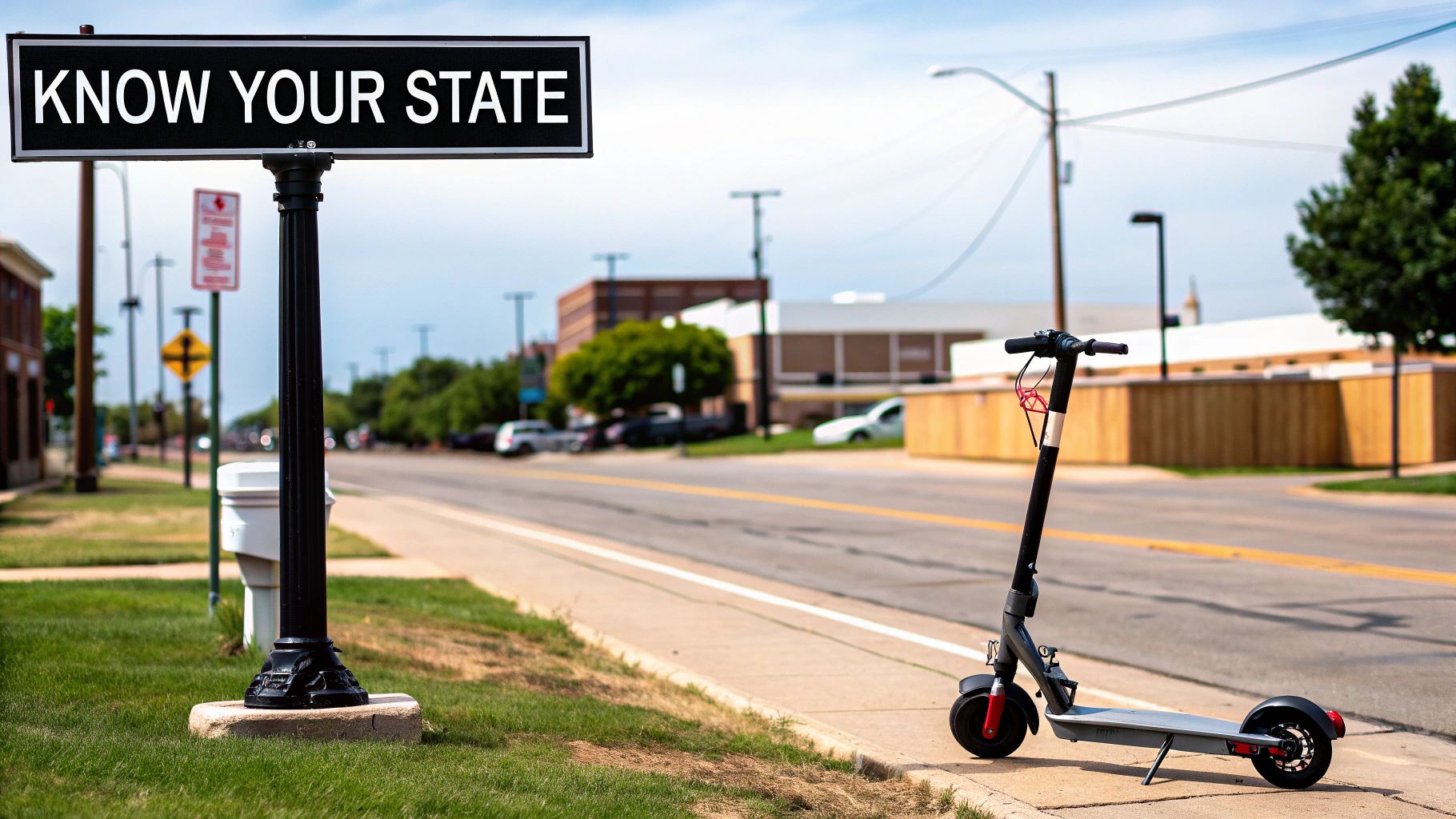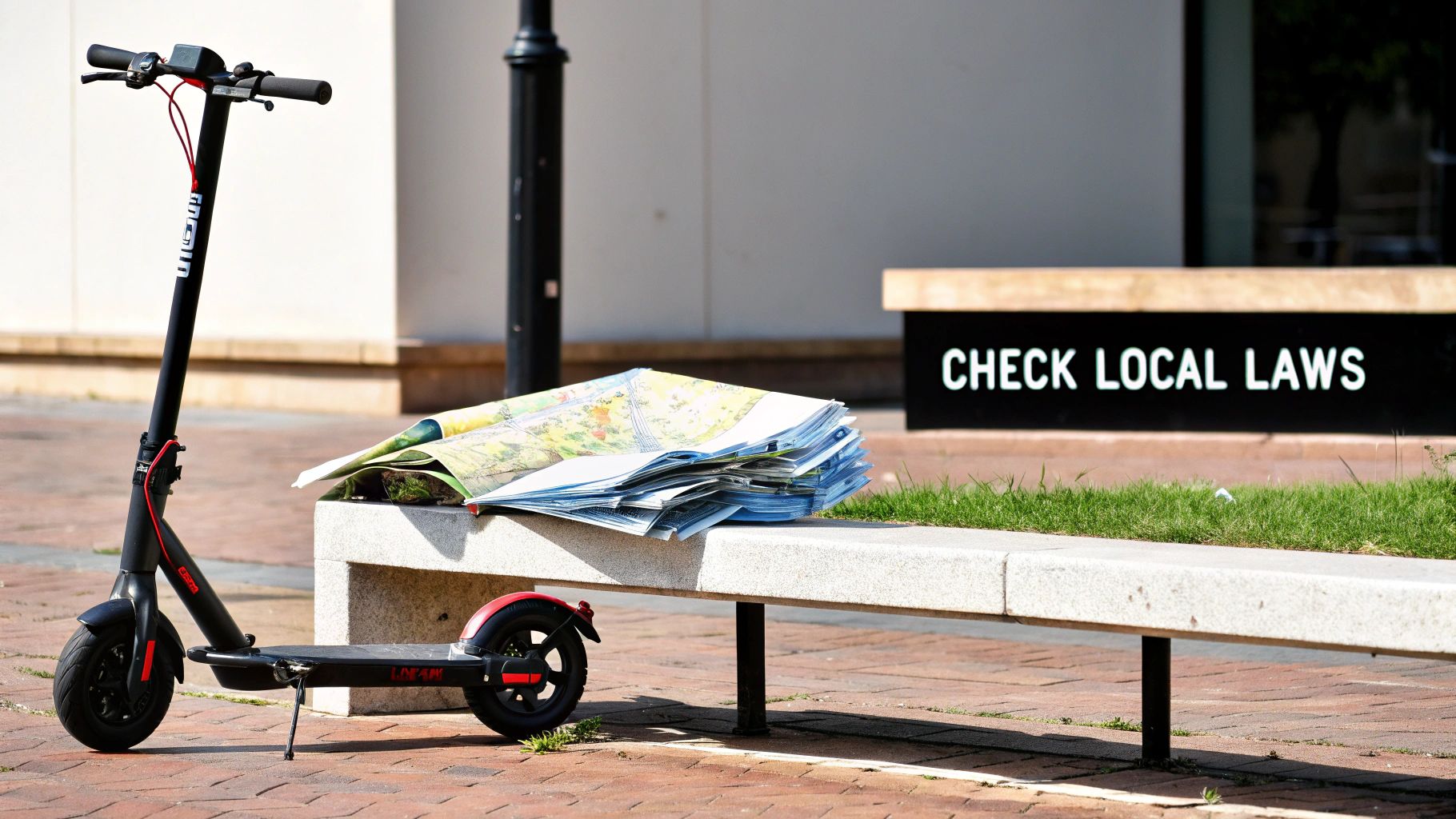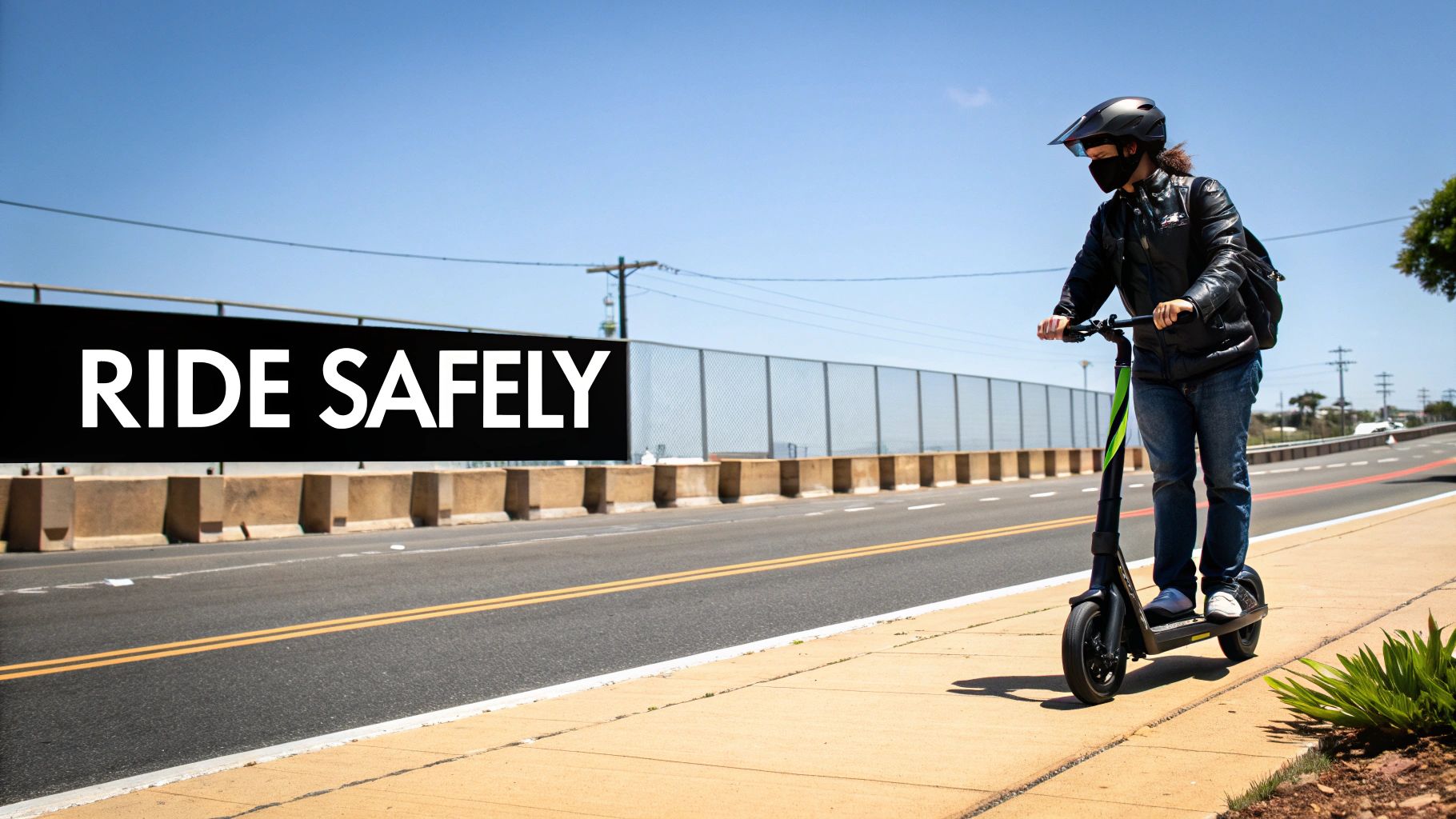So, are electric scooters street legal? The short answer is: it’s complicated.
The rules are a real patchwork, with every country—and sometimes even every state or city—making up its own mind. An e-scooter that's perfectly fine to ride in California might land you a hefty fine in Sydney.
Your Quick Guide to Global E-Scooter Laws
Trying to figure out e-scooter laws can feel like a headache. One place might classify them as "personal light electric vehicles" with a whole rulebook, while another just treats them like bicycles. This inconsistency is the biggest hurdle for riders just trying to follow the law.
Think of it like local driving customs. In some towns, everyone drives exactly the speed limit, while in others, the flow of traffic is what really matters. E-scooter rules on speed, helmets, and where you can ride change just as dramatically when you cross a border.

As you can see, it's never a simple "yes" or "no." The reality is a spectrum, from heavily restricted to widely accepted, all depending on where you are.
Why Do The Rules Differ So Much?
The heart of the issue is that laws are still playing catch-up with technology. E-scooters blew up in popularity way faster than governments could create specific rules for them. As a result, many places tried to cram them into existing vehicle categories where they just don't quite fit.
This leads to a few key differences you’ll find around the world:
- Vehicle Classification: Is it a toy, a bicycle, or a motor vehicle? Each label comes with its own set of rules for the road.
- Speed Limits: Most places that allow e-scooters cap their speed, usually somewhere between 15-20 mph (25-32 km/h). You can learn more about how speed affects legality in our guide to the average electric scooter speed limit.
- Where You Can Ride: Local laws dictate whether you’re allowed on sidewalks, in bike lanes, or on the street with cars.
To give you a clearer picture, here’s a quick breakdown of the general situation in a few major regions.
Global E-Scooter Legality At a Glance
| Region | Private E-Scooter Status on Public Roads | Key Considerations |
|---|---|---|
| United States | Varies by State and City | Some states have clear laws, while others leave it to local municipalities. Always check local rules. |
| Australia | Varies by State and Territory | Legal in some states like QLD and ACT, but heavily restricted or banned elsewhere, like NSW. |
| United Kingdom | Generally Illegal (with exceptions) | Legal only on private land or in government-approved rental trials. Rules are very strict. |
| European Union | Mostly Legal (with regulations) | Most EU countries have legalized e-scooters but with specific rules on speed, power, and insurance. |
This table just scratches the surface, but it shows how different the approaches can be.
The bottom line? Never assume the rules are the same from one place to the next. A quick search for local city or state ordinances before you ride is the smartest thing you can do to stay safe and legal.
The Wild West of E-Scooter Laws in the USA
So, are electric scooters street legal in the United States? The only honest answer is: it really depends on where you’re standing. There’s no single, nationwide law that covers e-scooters. Instead, you're navigating a confusing and sometimes downright frustrating patchwork of rules that can change from one state line to the next, or even one town over.
This fractured legal landscape means a ride that’s totally above board in one city could land you a hefty ticket just a few miles down the road. The truth is, the sudden explosion of e-scooters, both personal and shared, caught a lot of local governments flat-footed. They’ve been scrambling to create regulations ever since, and it often feels like the laws are still playing catch-up with the technology.
Progressive States and Cautious Cities
Some states have fully embraced the micromobility wave, setting up clear, statewide rules for riders. California is a great example. They took the lead by creating a framework that treats e-scooters a lot like bicycles, generally allowing them in bike lanes and on streets with lower speed limits.
California’s rules are refreshingly straightforward:
- Speed Cap: You can't go faster than 15 mph.
- Where to Ride: Stick to bike paths, bike lanes, or streets with a speed limit of 25 mph or less.
- Age and License: You need to be at least 16 years old and have a driver's license or a learner's permit.
This kind of clarity makes it easy for riders to know the rules of the road. But this isn’t the case everywhere. Many other states have punted the decision-making down to individual cities and counties, which is where things can get really complicated.
The heart of the problem in the U.S. is the absence of a unified federal standard. This puts the burden on riders to become amateur legal scholars, figuring out the specific rules for every single place they want to ride.
The Slow and Winding Road to Legalization
Now, compare California’s approach to a city like New York, where the journey to legalization was much more of a crawl. For years, e-scooters were in a legal no-man's-land. The city finally came around and legalized them, but with its own very specific and strict set of rules. It just goes to show how wildly different your experience can be, even within the same state.
The American electric scooter market is booming, which makes the need for consistent laws more urgent than ever. The market was valued at over $33 billion back in 2022, and you'll find about 86,000 shared e-scooters zipping around 250 different cities and towns. Despite how popular they've become, the regulations are still a tangled web. Some states welcome them with open arms while others still have outright bans or murky, confusing rules. To see a full picture of this chaos, check out our comprehensive guide to electric scooter laws by state.
At the end of the day, the most critical piece of advice for any rider in the USA is simple: always check the local laws first. Seriously. A quick Google search for the city or county's rules before you head out is the only way to be sure you’re riding safe, avoiding fines, and enjoying your trip with peace of mind.
Figuring Out E-Scooter Rules in Australia

If you’re asking, "are electric scooters street legal in Australia?" you’ve hit on a complicated topic. The situation down under is a lot like it is in the United States—there’s no single law for the whole country.
This means a perfectly legal cruise through Brisbane could land you in hot water in Sydney. It's a real patchwork quilt of regulations, with each state and territory making up its own mind.
Because of this state-by-state approach, you absolutely have to do your homework before hopping on. Some spots have jumped headfirst into micromobility, rolling out rental trials and creating clear rules for private owners. Others? They’re being a lot more careful and restrictive.
States Paving the Way
Queensland and the Australian Capital Territory (ACT) are probably the most scooter-friendly places you'll find. They’ve laid out clear guidelines that let both private and rental scooters use public paths, treating them like a real part of the transport system.
But even here, the rules are pretty specific.
- Queensland: You’ve got to keep your speed to 12 km/h on footpaths. In bike lanes or on local streets, you can open it up to 25 km/h. Helmets are a must, no excuses, and you need a bell and lights if you're riding after dark.
- ACT: The rules are quite similar. They allow up to 15 km/h on footpaths and 25 km/h everywhere else. And just like in Queensland, a helmet is a non-negotiable piece of gear.
These states are a great example of how to bring e-scooters into the fold safely. They’ve managed to strike a good balance between giving riders freedom and keeping everyone safe.
Where the Brakes Are Still On
Then you have places like New South Wales (NSW), which has taken a much harder line. You might spot rental e-scooters in certain trial areas, but privately owned ones are still banned from all public roads and footpaths. Taking your own scooter for a spin in Sydney could earn you some hefty fines.
The big takeaway for anyone riding in Australia is simple: your location is everything. What's perfectly fine in one state is illegal right across the border, which can be a nightmare for anyone travelling with their scooter.
This fractured legal scene shows that the country is still figuring things out. As more cities launch trial programs, the rules are constantly changing, so it's critical to check the very latest local laws before you head out for a ride.
Getting to Grips with UK E-Scooter Laws
So, are electric scooters legal in the UK? The answer isn't a simple yes or no, and it's a source of a lot of confusion. Let's break it down.
When it comes to your own privately owned e-scooter, the law is crystal clear and very strict: it is illegal to ride it on public roads, pavements, or even in cycle lanes. Period.
Why the tough stance? The law lumps them into a category called Personal Light Electric Vehicles (PLEVs). This puts them in the same boat as cars and motorbikes, meaning they'd need to have number plates, DVLA registration, insurance, and the rider would need a proper license. Your average e-scooter just isn't built to meet any of those requirements.
The UK's Two-Tier System
This is where things get interesting. Because of those strict rules, the only place you can legally ride your own e-scooter is on private land, and only if you have the landowner's permission.
But wait, you've probably seen people zipping around on e-scooters in cities all over the country. What's going on there? This is the second tier of the UK's unique system: government-approved rental trials.
Those rental scooters you see are the only exception to the rule. They're different because they are fully insured by the rental company and have been built to meet specific government safety standards.
In short, the UK has two different rulebooks. One for private e-scooters, which bans them from public spaces, and another for official rental scooters, which are allowed in specific trial areas.
This setup is the government's way of testing the waters, seeing how e-scooters work in a controlled way before they even think about making them legal for everyone.
What are the Rules for the Rental Trials?
Just because you can rent an e-scooter doesn't mean it's a free-for-all. You've still got to follow the rules to stay out of trouble. The official government guidance is pretty clear on this.
Here’s a quick look at the main points right from the source:

As you can see, you need at least a provisional driving licence to even ride one. You have to stay off pavements, and there's a speed limit—rental scooters are capped at 15.5 mph. Break these rules, and you could be looking at fines and even points on your driving licence.
A Look at E-Scooter Rules Across the European Union
Once you cross the channel from the UK into the European Union, you’ll find that electric scooters get a much warmer welcome. There isn’t a single, blanket law for the entire EU, but most member countries have opened their arms to e-scooters, building legal frameworks to make them part of everyday life.
So, when you ask if e-scooters are street legal in Europe, the answer is usually less about "if" and more about "how."
But don't mistake that for a free-for-all. Every country has its own spin on the rules, creating a real patchwork of regulations. The best way to get a feel for this is to look at a couple of key players, like Germany and France, who took different paths to get to a similar, scooter-friendly place.
The global move to legalize e-scooters happened fast. Germany was one of the first big European nations to jump in, officially making them road-legal back in May 2019. They green-lit e-scooters with a top speed of 20 km/h (about 12.4 mph) for use on public roads and bike paths, as long as they had basic safety gear like lights and brakes.
France wasn't far behind, setting a slightly zippier speed limit of 25 km/h (about 15.5 mph) and rolling out a clear system of fines to keep everyone in line. You can get a broader sense of how different places are handling things by checking out some insights on e-scooter legality worldwide.
How Germany Paved the Way
Germany’s approach is a textbook example of how to integrate a new technology thoughtfully. Instead of just reacting, they created an entirely new vehicle class for e-scooters called “Elektrokleinstfahrzeuge”—a mouthful that translates to "small electric vehicles."
By giving them their own official category, Germany gave e-scooters a clear legal home. This smart move sidestepped the confusion and legal gray areas that popped up elsewhere, making them a predictable and regulated part of traffic from day one.
To be street legal in Germany, your e-scooter needs to tick these boxes:
- Speed Limit: It can't go faster than 20 km/h.
- Insurance: You absolutely must have liability insurance, which you prove with a little sticker displayed on your scooter.
- Where to Ride: Bike lanes and roads are fair game, but pavements are strictly off-limits.
France: A Different Spin on Speed and Safety
France is just as welcoming to e-scooters, but they handle the rules a bit differently, especially when it comes to speed. The French government decided to allow a faster maximum speed of 25 km/h.
That extra bit of speed comes with tighter rules about where you can actually ride. Just like in Germany, riding on pavements is a big no-no to keep pedestrians safe. But in France, you're required to use bike lanes if they're available. You can only move onto the road if there’s no bike lane and the road's speed limit is 50 km/h or less.
The big takeaway here is that even within the pro-scooter EU, the devil is in the details. A scooter that's perfectly legal in one country could get you a fine right across the border because of a tiny 5 km/h difference in the speed limit.
This all points to the golden rule for any rider in Europe: always check the local laws. The EU might give a general thumbs-up, but each country—and sometimes even individual cities—gets to set its own specific rules. A quick search before you head out is the only sure way to ride safe and stay on the right side of the law.
Universal Safety Rules for Every E-Scooter Rider
Alright, so you’ve figured out the local laws. That’s half the battle. But knowing where you can ride is different from knowing how to ride safely.
Some rules of the road are just common sense, no matter if you're cruising through Berlin, Brisbane, or Boston. Think of these as the unwritten (and sometimes written) code for every scooter rider. Following them doesn't just keep you safe—it helps show everyone that scooter riders are a responsible part of the traffic mix.
The Bigger Picture: Riding for Tomorrow
Here's the thing: every time you ride, you're an ambassador for the entire e-scooter community. When people see riders being safe and considerate, it goes a long way.
It encourages cities to create smart, welcoming regulations instead of just banning scooters outright. Every safe, respectful ride you take is a vote in favor of keeping scooters on the street for good.
Your Global Rider Checklist
No matter where you are in the world, a few core habits will always serve you well. It really boils down to being aware of your surroundings and having respect for everyone else out there, from pedestrians to drivers.
Here's a quick rundown of practices that apply pretty much everywhere:
- Always Wear a Helmet: This is non-negotiable. Head injuries are the most serious risk you face. Even if it’s not legally required, a helmet is the single most important piece of gear you own. Studies have shown time and again that it drastically reduces the risk of severe injury.
- Give Pedestrians Their Space: Sidewalks are for people on foot, period. Even if your local rules technically allow sidewalk riding, it's a bad idea. If you absolutely have to share a path, slow way down and give walkers plenty of room.
- Bike Lanes are Your Best Friend: When you see a bike lane, use it. It's the safest place to be, separating you from both fast-moving cars and unpredictable pedestrians.
Before we get into the nitty-gritty, let's pull all the universal best practices into one simple table. Think of this as your go-to checklist before any ride, anywhere.
| Universal E-Scooter Rider Checklist | |
|---|---|
| Requirement Category | Common Rule or Best Practice |
| Personal Protective Gear | Always wear a certified helmet. Consider gloves and elbow/knee pads for extra protection. |
| Awareness & Focus | Stay off your phone. No headphones—you need to hear traffic around you. |
| Traffic Laws | Obey all traffic signals and stop signs, just like a car. |
| Pedestrian Interaction | Yield to pedestrians at crosswalks and on shared paths. |
| Riding Environment | Use bike lanes whenever they are available. Avoid sidewalks. |
| Rider Condition | Never ride under the influence of alcohol or drugs. |
| Scooter Maintenance | Check your brakes, tires, and lights before every ride. |
This checklist isn't exhaustive, but it covers the big stuff that keeps you and others safe on the road.
Your actions as a rider have a ripple effect. Every time you ride responsibly—stopping at signs, yielding to pedestrians, and wearing a helmet—you're not just protecting yourself. You're making a case for why e-scooters deserve a permanent and legal place on our streets.
These guidelines are a great starting point. For a more detailed guide, check out our complete list of electric scooter safety tips to help you stay safe on every trip.
Frequently Asked Questions About E-Scooter Laws

Still got a few questions buzzing around about e-scooter laws? Don't worry, that's completely normal. The rules can be a bit of a maze, so let's clear up some of the most common things riders ask.
Do I Need a Driver's License to Ride an Electric Scooter?
This is the classic "it depends" answer, and it really does depend on where you live. In a lot of US states (like California) and throughout most of the EU, you can hop on a standard scooter without needing any kind of license at all.
But in other places, a license is mandatory. For the official rental trials in the UK, having a provisional or full driving license is a must-have. No license, no ride.
Are E-Scooters Street Legal in New South Wales (NSW), Australia?
As of now, no. While you might see some specific rental trial schemes in certain council areas, privately owned e-scooters are not street legal in NSW. Riding your own scooter on public roads or footpaths there can result in significant fines. This is a key example of how rules can differ drastically from one state to another in Australia.
What is the Difference Between a Rental and Private E-Scooter Legally?
Legally speaking, especially in places like the UK and trial areas in Australia, the difference is night and day. The government-approved rental scooters you see in cities are part of specific trials and come with all the necessary insurance and safety features to be allowed on public roads.
Private e-scooters, on the other hand, often don't meet the strict legal requirements to be classified as proper motor vehicles, which is why they get relegated to private property in those regions. In other parts of the world, like the US or much of Europe, the laws tend to treat both types of scooters pretty similarly, though the rental companies often throw in their own set of rules for users.
Ready to hit the road legally and in style? Punk Ride LLC has an awesome selection of top-brand electric scooters and bikes that are good to go in scooter-friendly areas. You can find your perfect ride and join the urban mobility movement over at https://www.punkride.com.





Share:
Unpacking Electric Vehicle Maintenance Costs
Are Electric Bikes Waterproof? Your Guide to Safe Riding in Any Weather